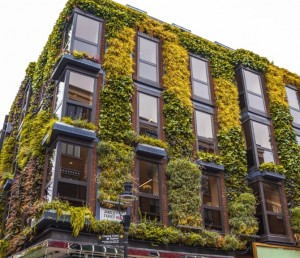Making architecture greener is a very popular topic at the moment. Incredibly you can get some of the benefits by literally making it green and including vertical gardens. You can grow all kinds of things on the facade of a property. It increases the amount of greenery, improves air quality, provides insulation, and can boost the aesthetics too. As one of the top choices for an architect London has, we want to take a closer look at these features.
Why choose one?
 The reasons above may be enough to convince you to look at installing a vertical garden. However, there are many more to keep in mind. Firstly, you can grow all kinds of things, even in areas where there is no usable space on the ground. There is also less maintenance with this kind of garden. It is less likely you will have problems with weeds and pests.
The reasons above may be enough to convince you to look at installing a vertical garden. However, there are many more to keep in mind. Firstly, you can grow all kinds of things, even in areas where there is no usable space on the ground. There is also less maintenance with this kind of garden. It is less likely you will have problems with weeds and pests.
Vertical gardens are also really efficient in terms of using resources. Typically they have hydroponic systems to deliver water directly to the plants on the surface. These delivery systems are far more effective than watering by hand on the ground. There can be less water waste as a result, especially with recirculating hydroponics.
How to create one?
There are a lot of overlaps with traditional horizontal growing here. This includes things like plant choice, layout, and water and nutrient needs. However there are some very important things to think about with vertical growing.
Decide what structure to use
This could be as simple as having a trellis for ivy to cling to. But you will probably want something more complex. When you are deciding what to use, think about the weight, whether you will be able to adapt or add to it in the future, and whether it is moveable. You also need to ensure that the plants you will grow won’t damage the surface itself.
Where to plant?
You have lots of choice here, but you need to ensure the plants will be able to get the light they need. Some will want bright sun whereas others prefer shade. If you are creating the vertical garden as a feature, you need to place it where it will make the biggest visual impact.
What to plant?
There are lots of options here too, so it will usually come down to a decision on how ambitious you want to be. Herbs are a good choice because they don’t require a lot of help to grow. They can be great focal points here. Or you can choose different types of climbing plants. You just need to make sure you can train them upwards properly. Just keep growing speeds and how aggressively some plants grow. You will want to focus on complementary planting so everything thrives.
Maintaining it
As we said, vertical gardens can require little in terms of watering. However to achieve this you need to make sure the hydroponic system picks up the slack. You can also use this to deliver the right nutrients to plants. You have to choose the right system and need to maintain it.
There is one important thing to keep in mind here; any gaps in a vertical garden will be very obvious. So a lot of your maintenance may be working to fill any that appear. It is a good idea to have plants ready to swap in.
Work with the top architect in London
Coffey Architects knows how wonderful living vertical gardens can be. They are great features for homes, commercial buildings, and public properties. Modern growing technology is fantastic so you can be very creative here.
So, if you are thinking about designing a property, speak to us. We can give you all of the support and advice you expect from one of the best options for an architect London has. You won’t regret working with us, especially when you see our creativity and the final results.
